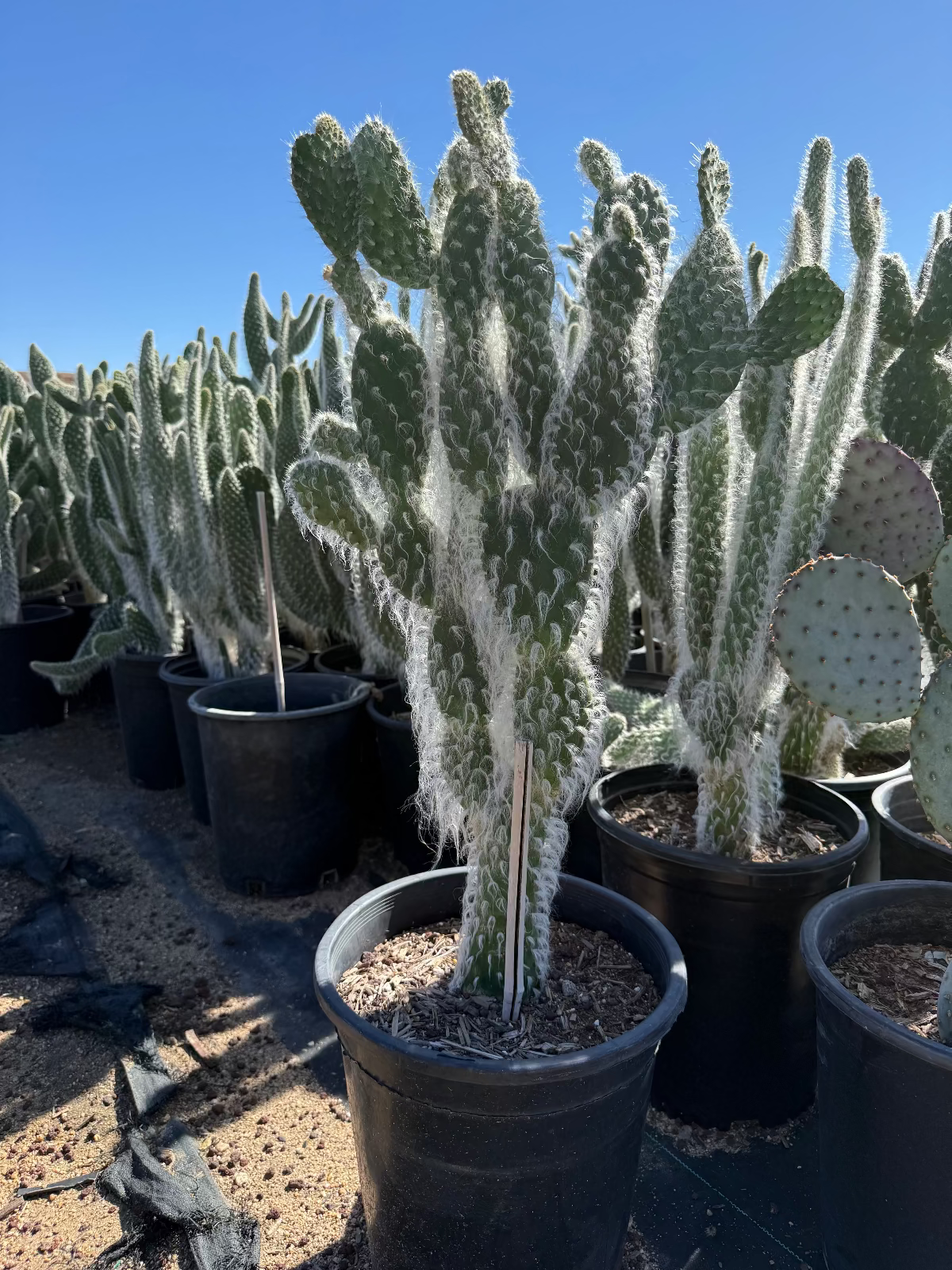My Store
Snow Prickly Pear
Snow Prickly Pear
Couldn't load pickup availability
Plant Type: perennial, shrubby prickly pear cactus
Plant Height: 2–3 feet (can reach 4 feet in maturity)
Spread: 3–5 feet
Flower Color: bright yellow with orange centers
Sun Exposure: Full sun
Snow Prickly Pear / Opuntia erinacea ursine ‘Snow’: A Frosted, Textured Jewel of the Desert
Opuntia erinacea ursine ‘Snow’, known as the Snow Prickly Pear, is a spectacular desert species prized for its frosty-white spines that give the plant a snow-dusted appearance even in the heat of summer. A selection of the hardy Hedgehog Prickly Pear group, this variety combines incredible cold tolerance with dazzling visual texture, making it one of the most striking and resilient prickly pears for Arizona landscapes. Its luminous white spines, golden-yellow blooms, and sculptural pads create a landscape accent that’s both rugged and refined.
Key Features of Opuntia erinacea ursine ‘Snow’
The Snow Prickly Pear forms upright, rounded clumps composed of flattened, oval pads that range from blue-green to silvery gray beneath a dense coating of fine, hairlike white spines. These soft, radiant spines are what give the plant its “snow” name, catching and diffusing sunlight to create a glowing, frosted effect.
In spring through early summer, this cactus bursts into brilliant yellow flowers with orange-red centers, each bloom about 2–3 inches wide. The contrast between the sunny flowers and the silvery pads is stunning, especially when sunlight passes through the spines. After flowering, red to purple fruits appear, providing additional visual interest and a food source for desert wildlife.
This variety is exceptionally cold hardy, making it a superb choice for both low and high desert gardens. It’s slow to moderate growing but long-lived, maintaining a neat, upright form that fits seamlessly into modern xeriscapes or natural desert designs.
Growing and Care Tips
Opuntia erinacea ursine ‘Snow’ thrives in full sun and extremely well-draining soil. In the Phoenix Valley, it performs best in open areas that receive abundant sunlight throughout the day, including reflected heat from stone or walls.
Plant it on a slope or raised bed to ensure quick drainage and prevent standing water. Water deeply but sparingly during the first few months after planting—about every 14–21 days depending on soil conditions. Once established, the Snow Prickly Pear requires minimal water, often thriving solely on natural rainfall.
It is among the most cold-tolerant prickly pears, withstanding temperatures down to 0°F or below, while also tolerating extreme summer heat. Avoid planting in low-lying areas where cold air or water may collect. Minimal pruning is needed—simply remove damaged or crowded pads as necessary.
For container use, select a wide, shallow pot filled with a gritty cactus mix or decomposed granite blend for optimal drainage.
Landscaping Uses
The Snow Prickly Pear brings a unique silvery-white tone to desert landscapes, adding brightness and contrast to green, gold, and blue plant palettes. Its soft, radiant color pairs beautifully with Blue Glow Agave, Golden Barrel Cactus, and Red Yucca, creating harmony through texture and tone.
It’s ideal for rock gardens, accent plantings, and desert courtyards, where its glowing spines and structured pads can be fully appreciated. When backlit by the morning or evening sun, it appears almost luminescent—like desert light frozen in form. The plant’s ability to thrive in both scorching summers and freezing winters makes it a standout choice for year-round visual impact and reliability.
Summary
The Snow Prickly Pear (Opuntia erinacea ursine ‘Snow’) is a masterpiece of natural design—resilient, radiant, and refined. With its luminous white spines, golden blooms, and exceptional cold hardiness, it’s as functional as it is beautiful. Perfect for Arizona landscapes seeking a touch of elegance and contrast, this prickly pear adds year-round brilliance while thriving under the most extreme desert conditions.
Three Timbers Installation Guide (Feel Free to Follow):
Opuntia erinacea ursine ‘Snow’ Planting Guide:
Location: Full sun; choose an exposed site with 8+ hours of direct sunlight daily. Performs exceptionally well in reflected heat and rocky terrain.
Soil: Use sharply draining soil composed of cactus mix blended with sand, pumice, or decomposed granite. Avoid clay or compacted soils.
Spacing: Allow 3–5 feet between plants or nearby structures to accommodate mature spread and airflow.
Planting Depth: Keep pads level with or slightly above soil grade to prevent moisture buildup at the base.
Support: None required; pads will stabilize and root naturally under warm, dry conditions.
Watering Guide:
Watering After Planting: Water deeply once after installation to settle the soil. Then allow it to dry completely before watering again. During the first 3–4 months, water every 14–21 days depending on heat and soil drainage.
When is the Plant Established? The Snow Prickly Pear is considered established after 6–9 months, when new pad growth appears and the pad color deepens to silver-blue.
Watering Once Established: Water every 4–6 weeks in summer if no rainfall occurs. In winter, watering is typically unnecessary except during prolonged drought.
Drip Irrigation Setup: Install one low-flow emitter (1 gallon per hour) about 12–18 inches from the base, angled outward. Run sparingly and allow complete drying between cycles.
General Watering Tips: Always confirm soil dryness before watering. Overwatering can cause pad shriveling or root rot. A top dressing of decomposed granite or light gravel enhances appearance, prevents splash, and highlights the plant’s snowy spines. Keep material several inches from the base for airflow and long-term health.
Share














